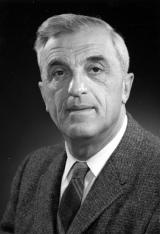
Felix Bloch, Neutron Induction, and Bloch EquationsResources with Additional Information Stressing "the importance both of demonstrating the neutron's magnetic moment and of determining its magnitude", Felix Bloch began his research on neutron physics at Stanford [University] in early 1936. "Using mostly X-ray and microwave equipment from the physics labs, he and Norris Bradbury ... built [a neutron] source ... . (Bloch later pointed out that this equipment was more important as a source of inspiration than of neutrons.) Eventually, he extended his use of neutron sources to studies of neutron polarisation, a link to his earlier research in ferromagnetism.  Courtesy Stanford University Archives These studies served as a basis for a collaborative effort with Luis Alvarez ... . In the fall of 1938, Alvarez and Bloch began working with Berkeley's 37" cyclotron to determine the magnetic moment of the neutron. ... By the summer of 1939 ... they were able to publish very precise results. This experiment was, in fact, one of the first important uses of Ernest Lawrence's cyclotron. .. In 1942, [J. Robert] Oppenheimer asked Bloch to work on the Manhattan Project. Bloch, collaborating with [Hans] Bethe, [Edward] Teller, and [Hans] Staub, used the homemade Stanford cyclotron for the first experimental determination of the energy distribution of neutrons from fission. After this was completed, Bloch left for Los Alamos, New Mexico where he worked on special theoretical problems under Bethe's supervision. At a meeting of the American Physical Society in December [1945]. Bloch met... [Edward] Purcell of Harvard University and the two discussed their recent research. Both recognized that the theoretical basis of their respective projects was the same, although they had been using slightly different techniques to achieve experimental results. So they decided to split up the field: Bloch would use the effect in the study of liquids; Purcell would examine crystals. The Stanford group gathered its first positive results in January 1946 (see Physical Review 69, 127(L) (1946)). " Bloch was recognized for his achievements when he was awarded the 1952 Nobel Prize for Physics for the ‘development of new methods for nuclear magnetic precision measurements and discoveries in connection therewith'. Further recognition for Bloch came in 1954 when he was asked to serve as the first Director-General of the European Center for Nuclear Research (CERN). After a year in this position, he returned to Stanford where, "[d]uring the next few years, he and Leonard Schiff, department chairman from 1954 through 1966, built one of the leading physics teaching and research facilities in the world. They and the other senior members of the department persuaded the Atomic Energy Commission to construct the huge linear accelerator" (SLAC). "As such a well-known scientist, Bloch was involved with many professional organizations... includ[ing] the American Academy of Arts and Sciences, the American Philosophical Society, the National Academy of Sciences, the Weizmann Institute of Science, and the American Physical Society. He was appointed an honorary member of the Swiss Physical Society and received honorary degrees from Grenoble University, Oxford University, the University of Jerusalem, and the University of Zurich. In 1965, he served as president of the American Physical Society, one of the largest scientific organizations in the country." - Edited excerpts from Biographical
Note: The Life and Work of Felix Bloch
Resources with Additional InformationAdditional information about Felix Block and his work is available in full text and on the Web. Documents:
A Quantitative Determination of the Neutron Moment in Absolute Nuclear
Magnetons; Physical Review, Vol. 57, Issue 2: 111-122, January
15, 1940
Fission Spectrum, August 18, 1943 A Quantitative Determination of the Magnetic Moment of the Neutron in Units of the Proton Moment; Physical Review, Vol. 74, Issue 9: 1025-1045, November 1, 1948 A Direct Determination of the Magnetic Moment of the Proton in Nuclear Magnetons; Physical Review, Vol. 80, Issue 2: 305-306, October 15, 1950 Theory of Line Narrowing by Double-Frequency Irradiation; Physical Review, Vol. 111, Issue 3: 841-853, August 1, 1958 Energetic Stability of Persistent Currents in a Long Hollow Cylinder; Physical Review, Vol. 128, Issue 4: 1697-1714, November 15, 1962 Additional Web Pages:Chronology – Bloch (Felix) Papers; Online Archive of California, Stanford University Archives Bloch States: Not for Electrons Only A Life-Saving Window on the Mind and Body: The Development of Magnetic Resonance Imaging Biographical Memoirs V.64 (1994); National Academy of Sciences; Felix Bloch – pages 34 - 71 |


 |
Information
Bridge • Energy
Citations Database • E-print
Network • R&D
Accomplishments
About OSTI Science.gov • USA.gov • USAJOBS • Grants • Regulations.gov |
|---|